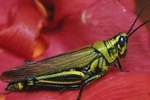
The expression "eat you out of house and home" is no joke when it comes to wood-destroying insects. These munchers do millions of damage to buildings each year. While the first bug that comes to mind is termites, there are others that can be equally damaging.
Carpenter Ants
Carpenter ants are ants, and all ants have a waist -- a pinched-in section of their bodies between the thorax (chest) and the abdomen -- which termites do not have. Carpenter ants' bodies are dark, while termites' are light. Ants have bent antennae, but termites' are straight. The most obvious difference, however, is in the wings: termites have two pair of equal length, while in carpenter ants the rear pair is shorter than the front pair. Unlike termites, carpenter ants do not eat wood, they just make tunnels in it to live in.
Flying Ants
Flying ants are not a separate species; they are the breeding adults of any kind of ant. They fly to mate in the spring, then shed their wings to begin a new colony. Some of the same characteristics of carpenter ants distinguish any species of ant from any species of termite: paired wings of different sizes, a constricted body center and bent or "elbowed" antennae.
Powderpost Beetles
Beetles don't look much like termites or ants -- other than in general insect attributes, such as six legs -- but the damage they do to wood can look like, and be as bad as, that done by termites. Powderpost beetle larvae actually eat wood, as termites do. To determine if the damage is caused by powderpost beetles, look closely at damaged area for a very fine, almost dust-like residue. This is "frass," a mixture of feces and wood fragments. If the frass is more pellet-like and has ridges on the sides, it's from termites.
Carpenter Bees
Carpenter bees resemble bumblebees, but have a smooth, shiny abdomen instead of hairy one, like the bumblebee's. Like carpenter ants, carpenter bees do not eat wood -- they dig tunnels into it to nest. They make a large round hole, sometimes almost fingertip size. They commonly attack wood that is bare, weathered and unpainted. The male is harmless, but the female can sting and will defend her nest. To treat existing nests, puff insecticide dust into the holes and let the bees carry it inside. To prevent them from re-using old nests, plug the holes and paint the wood.
References
Resources
Photo Credits
-
Hemera Technologies/Photos.com/Getty Images




